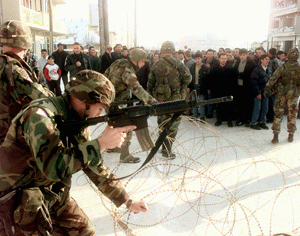The
US Army National Guard (ARNG) is in trouble.
The problem
is not a lack of support in Congress, and not pressure to downsize by the
regular Army. The ARNG is in
trouble because its Cold War equipment is aging, expensive to operate, and inappropriate for likely missions. The
ARNG must shed its armored vehicles and convert units into urban
infantry. This
will allow the eight ARNG divisions to change focus from the Soviet threat and
concentrate on these urban infantry missions: 
1)urban combat
2)peacekeeping/riot control
3)rear-area security
4)disaster relief/refugee camps
These are not glamorous missions, but they are ideal for the
ARNG because they are manpower intensive, which means cost-effective for a
reserve force. The overall cost for
two
ARNG tank battalions equal that of one active-duty tank battalion.
This is because of the high operating, maintenance, and training costs of
tanks. However, infantry units
require much
less equipment that is inexpensive to maintain.
As a result, five ARNG infantry battalions cost the same as one active
duty infantry battalion.
A second reason is that urban infantry missions are shunned. The regular Army is still focused on defeating Soviet armor thrusts into Germany, although battles with Iranian tanks are substituted. The Army learned from its conflict in Iraq that it lacked the manpower and skills for urban infantry operations. Fortunately, most ARNG units are located in urban areas where members can coordinate access to varied urban training areas. Many guardsmen are employed in urban related security tasks, such as policemen, prison guards, firemen, and civil engineers. If the ARNG focused training on urban infantry missions, it can develop greater proficiency in these tasks than active duty infantry.
For example, the regular army is reluctant to devote combat forces to guard airbases. When a US Air Force Wing deploys overseas, its base security units must still guard its home base while providing more robust 24-hour security overseas. Therefore, Air Force Wings should adopt a local ARNG infantry battalion, which can train with the Wing and deploy when necessary. Reserve infantry battalions will be assigned a myriad of tasks, such as headquarters security, bridge security, and base camp security. They will also be a manpower pool to support engineer units, and may be trained as truck drivers when more are needed.
 If the Army
becomes involved in a lengthy conflict, basic infantry requirements will quickly
sap manpower from regular fighting divisions.
If ARNG units are specifically trained for such missions, regular Army
Generals will include them
in war plans, especially since infantry units
suffer heavy casualty rates in combat. A final reason is that the most important role
If the Army
becomes involved in a lengthy conflict, basic infantry requirements will quickly
sap manpower from regular fighting divisions.
If ARNG units are specifically trained for such missions, regular Army
Generals will include them
in war plans, especially since infantry units
suffer heavy casualty rates in combat. A final reason is that the most important role
The ARNG must adopt an urban infantry structure for
all its combat brigades. The mechanized infantry
structure is too heavy while the light
infantry structure is too light. While
mechanized forces perform well in heavy combat in urban areas, many urban
missions are primarily infantry.
The standard ARNG infantry brigade will have foot infantry battalions backed by a support battalion that provides trucks and logistical
support, and includes a company of Rhinos, and
an anti-aircraft company with 40mm automatic cannons, which are excellent for infantry
support as well.
Although 90% of reservists will agree to these reforms, change will be
resented by some officers who view the ARNG as a club that exists for their
benefit. Tankers will oppose converting to
difficult grunt work, and thousands
of full-time civilian employees who maintain ARNG tanks and armored personnel carriers may lose their
jobs. In addition, defense
contractors who
provide spare parts would lose billions of dollars in business.
©2006 www.G2mil.com